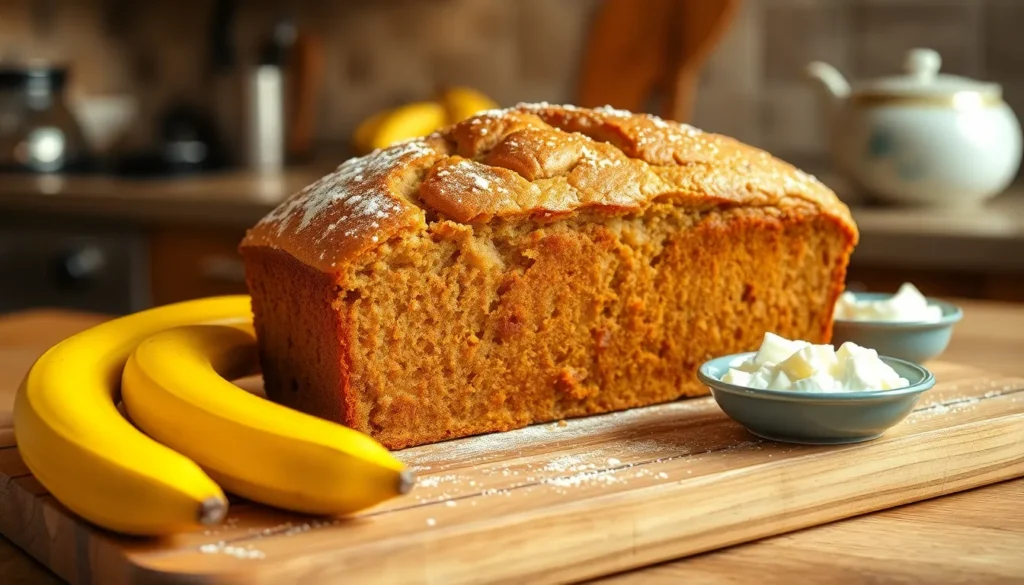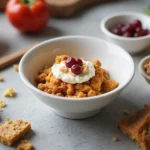We’ve discovered the perfect way to transform your overripe bananas into something extraordinary – cottage cheese banana bread that’ll revolutionize your baking game. This protein-packed twist on classic banana bread combines the creamy richness of cottage cheese with sweet mashed bananas to create an incredibly moist and nutritious loaf that’s perfect for breakfast or an afternoon snack.
What makes this recipe truly special is how the cottage cheese adds an extra boost of protein while keeping the bread tender and fluffy. You won’t even taste the cottage cheese – it simply melts into the batter and creates the most amazing texture we’ve ever experienced in banana bread.
Ingredients
We’ve carefully balanced each ingredient to create the perfect cottage cheese banana bread that’s both nutritious and deliciously moist. Our ingredient list features simple pantry staples that work together to deliver exceptional flavor and texture.
Wet Ingredients
- 3 large ripe bananas, mashed (about 1 cup)
- 1 cup cottage cheese, small curd or large curd
- 2 large eggs, room temperature
- 1/3 cup melted butter or coconut oil
- 1/4 cup milk of choice
- 2 teaspoons vanilla extract
- 1 tablespoon fresh lemon juice
Dry Ingredients
- 1 3/4 cups all purpose flour
- 3/4 cup granulated sugar
- 1 teaspoon baking soda
- 1/2 teaspoon baking powder
- 1/2 teaspoon salt
- 1 teaspoon ground cinnamon
- 1/4 teaspoon ground nutmeg
Optional Add-ins
- 1/2 cup chopped walnuts or pecans
- 1/3 cup mini chocolate chips
- 2 tablespoons rolled oats for topping
- 1 tablespoon chia seeds or flax seeds
- 1/4 cup dried cranberries or raisins
- 1 teaspoon orange zest for citrus brightness
Equipment Needed
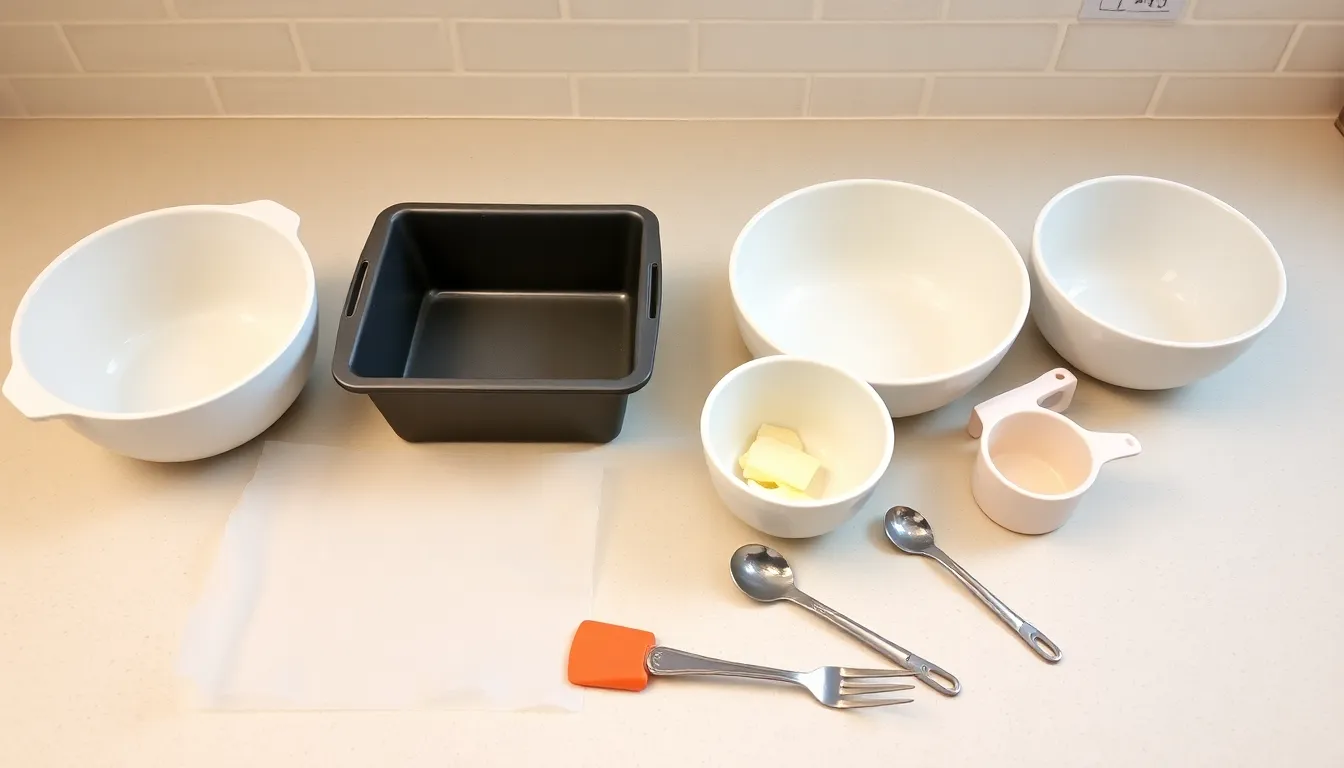
Making cottage cheese banana bread requires basic baking equipment that most home kitchens already have. We recommend gathering all necessary tools before starting to ensure a smooth baking process.
Essential Baking Equipment:
- 9×5-inch loaf pan – Standard size provides proper depth and width for even baking
- Parchment paper – Lines the pan for easy removal and prevents sticking
- Large mixing bowl – Accommodates wet ingredients and allows proper mixing
- Medium mixing bowl – Perfect for combining dry ingredients separately
- Measuring cups and spoons – Ensures accurate ingredient proportions
- Rubber spatula – Gently folds ingredients without overmixing
- Fork or potato masher – Mashes bananas to desired consistency
Optional but Helpful Tools:
- Blender or food processor – Creates ultra-smooth cottage cheese texture if preferred
- Wire cooling rack – Allows proper air circulation during cooling
- Kitchen scale – Provides precise measurements for consistent results
- Toothpick or cake tester – Tests doneness without cutting into the bread
We find that having everything ready before mixing makes the process much more efficient. The blender option works particularly well for those who prefer completely smooth cottage cheese integration rather than small curds throughout the bread. Room temperature ingredients mix more easily, so we suggest removing eggs and cottage cheese from the refrigerator about 30 minutes before baking.
Instructions
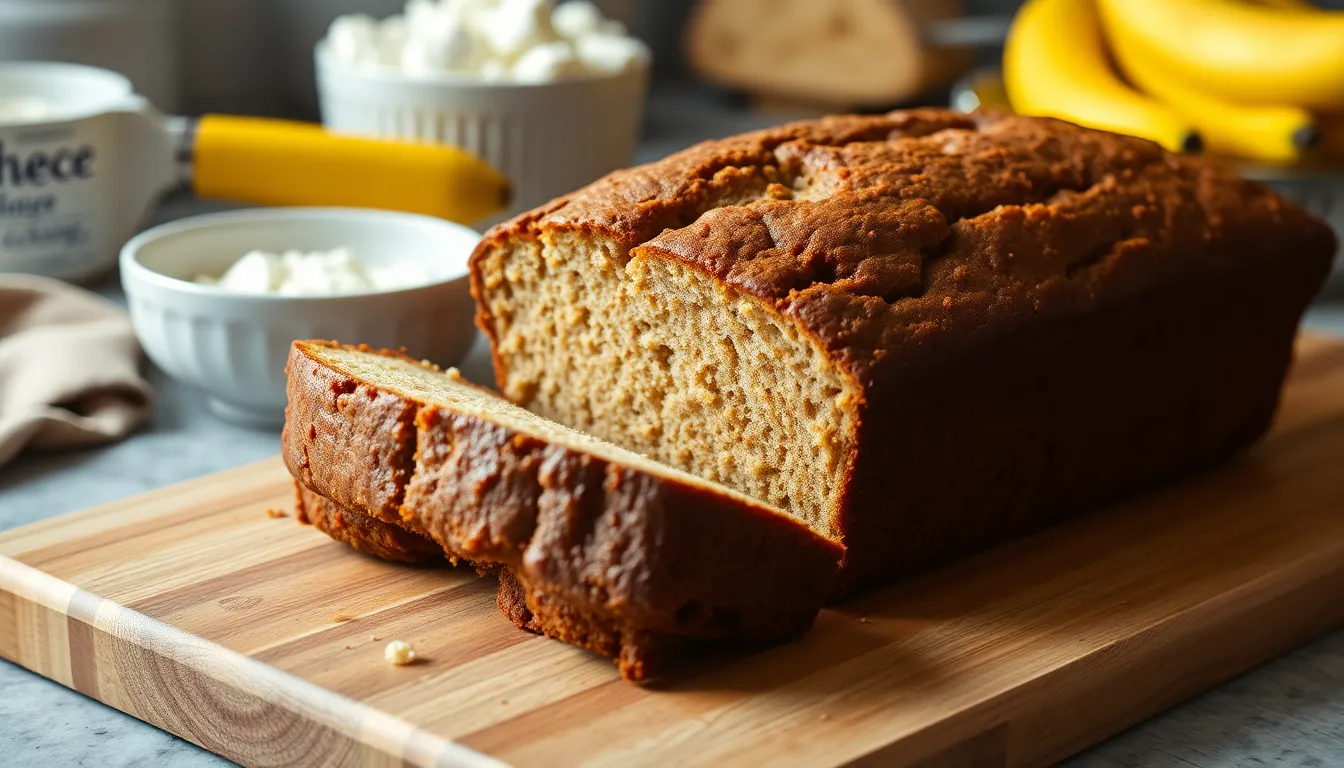
We’ll guide you through creating this protein-packed cottage cheese banana bread with clear, manageable steps. The process involves three main stages that ensure perfect results every time.
Prep Work
We start by preheating our oven to 350°F (175°C) to ensure consistent baking temperature. Next, we line our 9×5-inch loaf pan with parchment paper and lightly grease it to prevent sticking.
We gather all our ingredients and bring the cottage cheese, eggs, and milk to room temperature for easier mixing. The bananas should be very ripe with brown spots for maximum sweetness and easy mashing.
Making the Batter
We begin by mashing our ripe bananas in a large bowl until smooth, leaving just a few small lumps for texture. In the same bowl, we whisk together the mashed bananas, cottage cheese, eggs, melted butter, milk, vanilla extract, and lemon juice until well combined.
In a separate medium bowl, we whisk together the all-purpose flour, granulated sugar, baking soda, baking powder, salt, cinnamon, and nutmeg. We then gradually fold the dry ingredients into the wet mixture using a rubber spatula, stirring just until combined.
We avoid overmixing to prevent a dense texture, stopping as soon as we no longer see streaks of flour. If using optional add-ins like nuts or chocolate chips, we gently fold them in at this stage.
Baking the Bread
We pour the batter into our prepared loaf pan, spreading it evenly with a spatula. The bread bakes for 50-65 minutes, or until a toothpick inserted into the center comes out mostly clean with just a few moist crumbs.
If the top begins browning too quickly after 40 minutes, we cover it loosely with aluminum foil to prevent burning while the center finishes cooking. We allow the bread to cool in the pan for 10 minutes before transferring it to a wire rack to cool completely.
Directions for Cooling and Storage
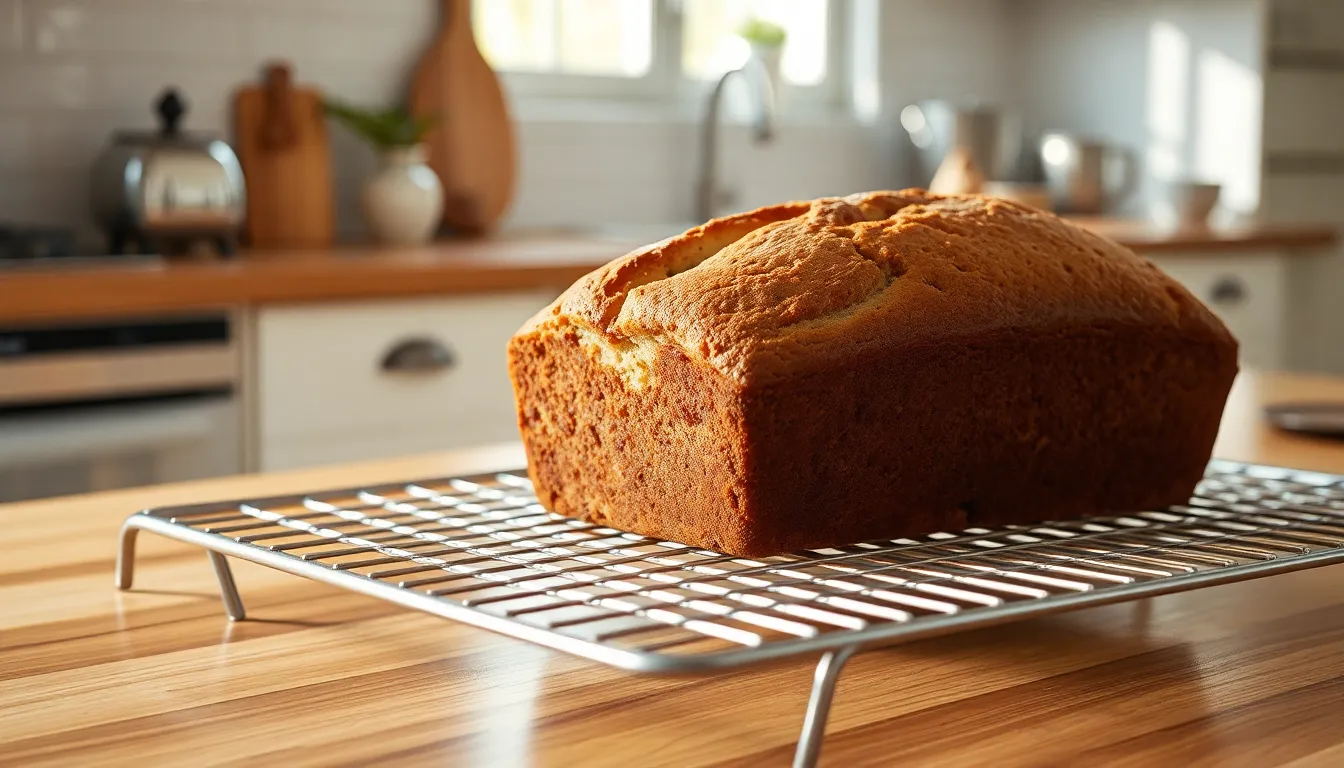
Once our cottage cheese banana bread finishes baking, we need to follow proper cooling procedures to achieve the best texture and prevent crumbling. We allow the bread to rest in the loaf pan for exactly 10 minutes after removing it from the oven. This initial cooling period lets the structure set properly while the bread remains warm enough to release from the pan easily.
After the 10-minute rest period, we carefully transfer the bread to a wire rack for complete cooling. Running a knife around the edges helps loosen the bread before turning it out of the pan. We let the bread cool completely on the wire rack before slicing to ensure clean cuts and optimal texture.
| Storage Method | Duration | Container Requirements |
|---|---|---|
| Room Temperature | Up to 3 days | Airtight container |
| Refrigeration | Up to 5 days | Airtight container |
| Freezing | Up to 2 months | Tightly wrapped |
For short-term storage, we keep our cottage cheese banana bread in an airtight container at room temperature for up to three days. The bread maintains its moisture and flavor beautifully during this period without refrigeration.
When we need extended storage, refrigeration keeps the bread fresh for up to five days. We place the completely cooled bread in an airtight container before refrigerating to prevent it from drying out or absorbing other flavors.
For long-term storage, we wrap individual slices or the entire loaf tightly in plastic wrap or aluminum foil before placing in the freezer. Our cottage cheese banana bread freezes exceptionally well for up to two months without losing quality. We thaw frozen slices at room temperature or warm them briefly in the microwave before serving.
These storage guidelines work effectively for all variations of cottage cheese banana bread, whether we use almond flour, oat flour, or all-purpose flour in our recipe. Proper cooling and storage ensure we can enjoy our protein-rich banana bread at its peak quality for days or even months after baking.
Make-Ahead Instructions
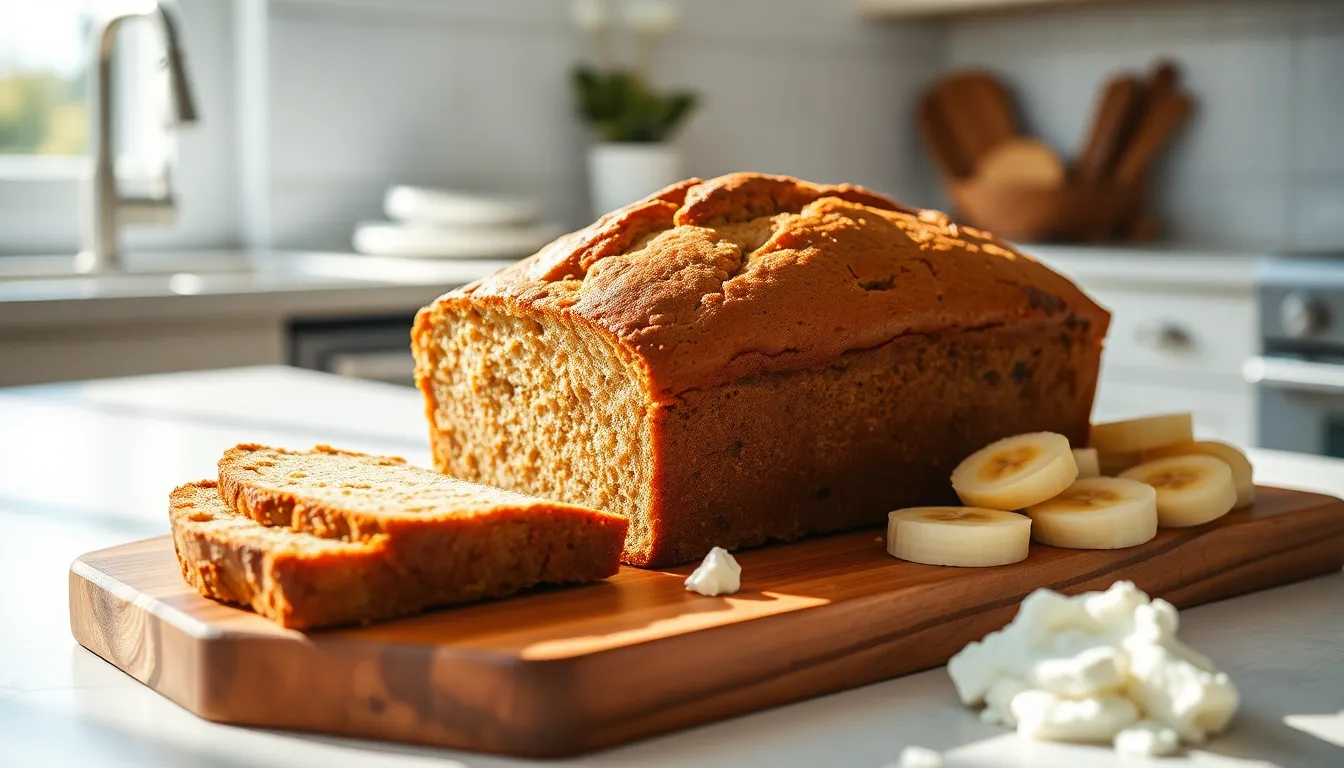
We can prepare this cottage cheese banana bread ahead of time using several convenient methods that maintain its moist texture and rich flavor. These make-ahead strategies save time during busy mornings and ensure we always have a nutritious protein-packed treat ready to enjoy.
Prepare Batter in Advance
Mixing the batter the night before streamlines our baking process. We combine all wet and dry ingredients according to the recipe directions and transfer the finished batter to our prepared loaf pan. Covering the pan tightly with plastic wrap allows us to refrigerate the unbaked batter for up to 24 hours. When ready to bake, we remove the pan from the refrigerator and let it sit at room temperature for 15 minutes before placing it in the preheated 350°F oven. This method may require an additional 5-10 minutes of baking time due to the chilled batter.
Freeze Unbaked Batter
Freezing the prepared batter extends our make-ahead timeline up to 3 months. We pour the mixed batter into a lined loaf pan and wrap it securely with aluminum foil followed by a layer of plastic wrap. Labeling the package with the date and baking instructions helps us stay organized. To bake from frozen, we thaw the batter overnight in the refrigerator and follow the same room temperature resting period before baking.
Bake and Store
Fully baking the cottage cheese banana bread ahead of time provides the most flexibility for our schedule. We can bake the bread up to 3 days in advance and store it in an airtight container at room temperature. For longer storage, we wrap the completely cooled bread in plastic wrap and aluminum foil before freezing for up to 2 months. Individual slices can be wrapped separately and frozen for quick single-serving portions that thaw in just 30 minutes at room temperature.
Serving Suggestions
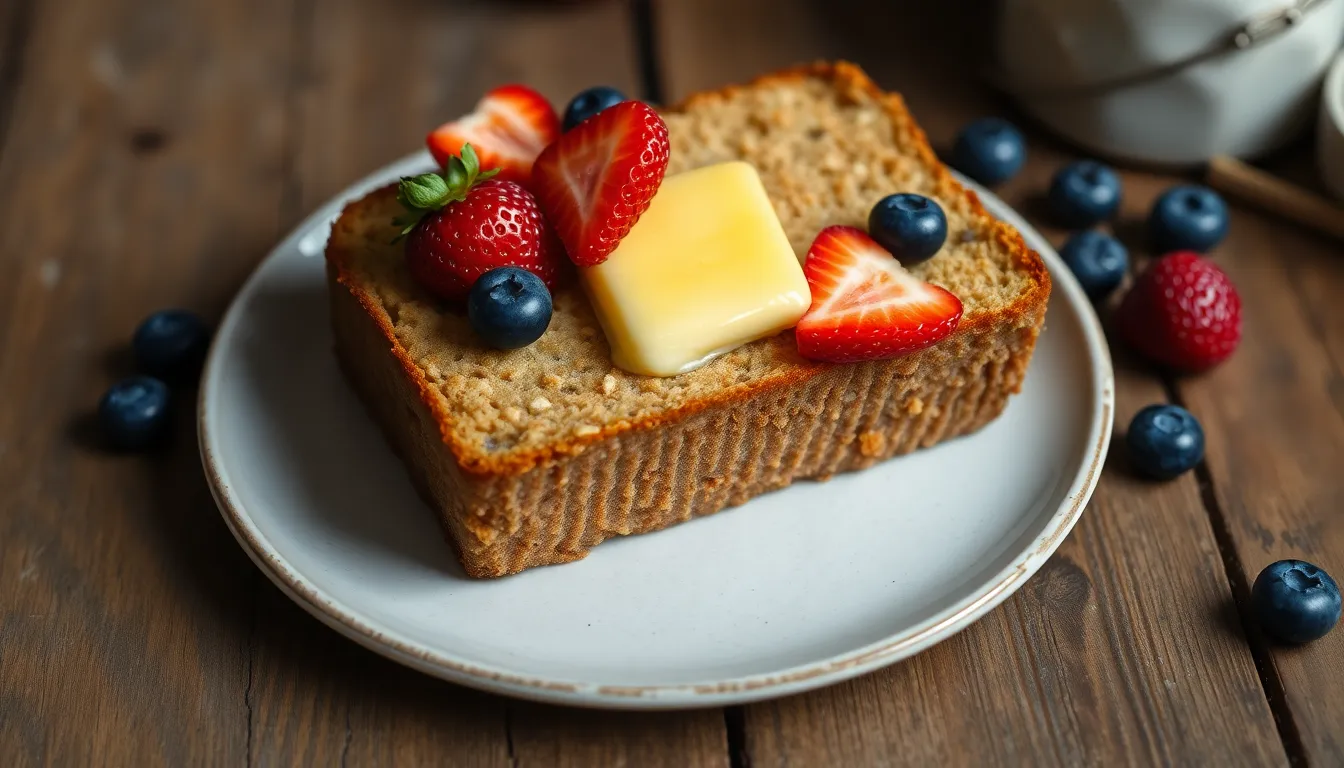
Our cottage cheese banana bread shines brightest when served warm from the oven with a pat of butter melting into each slice. We love spreading jam or honey across the surface to enhance the natural sweetness while adding complementary flavors that pair beautifully with the banana base.
Adding a dollop of Greek yogurt transforms each serving into a protein powerhouse breakfast or snack. The creamy yogurt provides an extra boost of nutrients while creating a delightful contrast in textures that elevates the overall eating experience.
Fresh fruit toppings bring vibrant colors and natural sweetness to every bite. We recommend sliced strawberries, blueberries, or banana rounds that echo the bread’s primary flavor while adding visual appeal and nutritional value.
Chopped nuts scattered across the surface create an irresistible crunch that complements the bread’s tender crumb. Walnuts work particularly well since they enhance the nutty undertones without overwhelming the delicate cottage cheese texture.
For an indulgent treat, we suggest serving thin slices alongside morning coffee or afternoon tea. The bread’s moist consistency and subtle protein content make it an ideal companion to hot beverages while providing sustained energy throughout the day.
Room temperature serving allows the full flavor profile to emerge while maintaining the perfect texture balance. We find that slightly warmed slices bring out the banana essence more prominently while keeping the cottage cheese contribution subtle and undetectable.
Toasted slices develop a golden exterior that adds textural interest while preserving the soft interior. This preparation method works exceptionally well for day-old bread that benefits from the gentle warming process.
Tips for Perfect Cottage Cheese Banana Bread
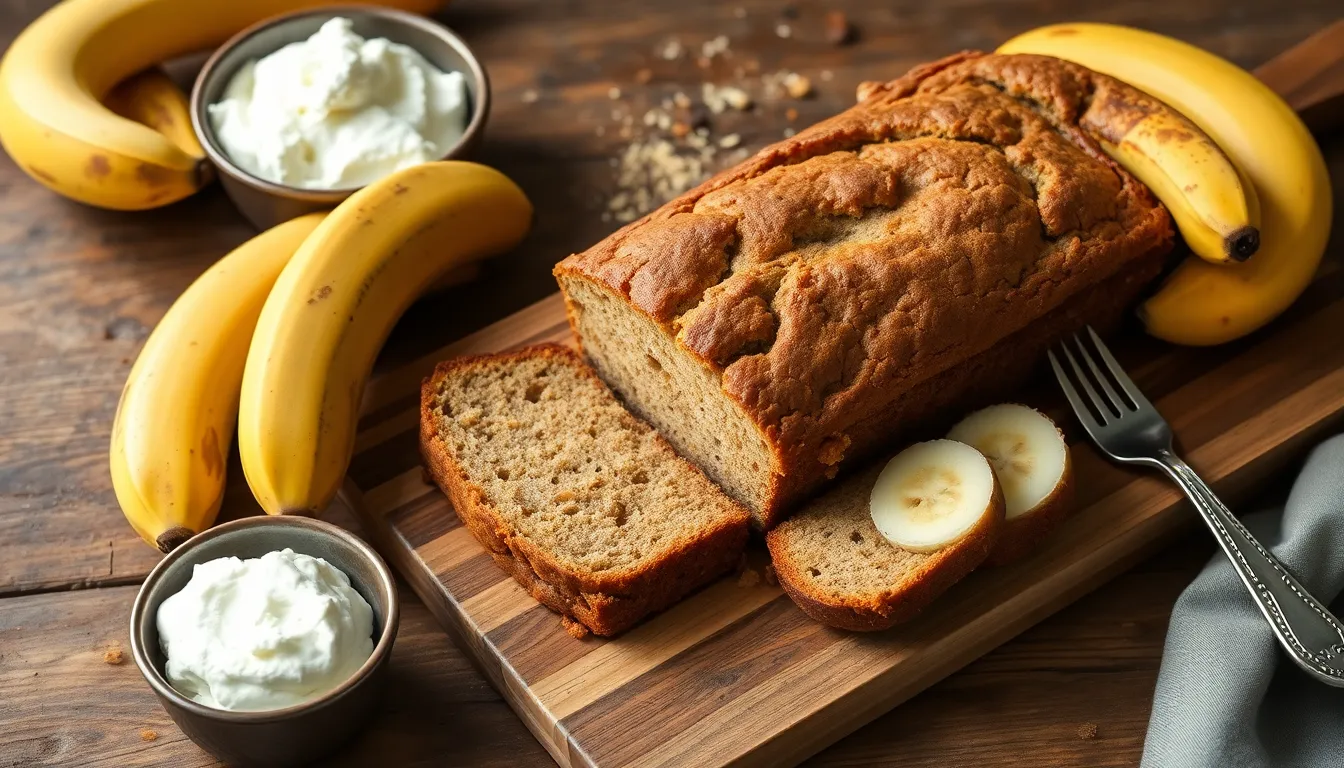
We’ve gathered essential tips to help you achieve the perfect cottage cheese banana bread every time. These proven techniques will elevate your baking results and ensure consistently delicious outcomes.
Choosing the Right Bananas
Overripe bananas with visible “freckles” deliver the best flavor and natural moisture for our bread. The more freckles present on the banana peel, the sweeter our finished bread will taste. We recommend selecting bananas that feel soft to the touch and have developed those telltale brown spots across their skin.
Mashing the bananas thoroughly ensures they distribute evenly throughout our batter. Use a fork or potato masher to break down the fruit until no large chunks remain. This preparation step prevents uneven pockets of banana from creating texture issues in our final loaf.
Cottage Cheese Selection
Full-fat cottage cheese works excellently in this recipe, though low-fat varieties also produce wonderful results. The cottage cheese functions as both a fat substitute and protein booster, contributing to the bread’s nutritional value without compromising taste. We find that either option creates the moist, tender crumb we’re seeking.
Blending the cottage cheese until smooth prevents unwanted lumps from appearing in our finished bread. Process the cottage cheese in a blender or food processor for 30-60 seconds until it reaches a creamy consistency. This extra step ensures our bread maintains a uniform texture throughout every slice.
Texture and Moisture Tips
Avoiding overmixing preserves the tender crumb structure we want in our banana bread. Mix ingredients just until they combine, leaving some small lumps rather than creating a perfectly smooth batter. Overmixing develops the gluten too much, resulting in dense, tough bread instead of the light texture we’re aiming for.
Testing for doneness prevents overbaking, which can dry out our bread significantly. Insert a toothpick into the center of the loaf and look for it to come out mostly clean with just a few moist crumbs attached. Completely clean toothpicks often indicate the bread has baked too long.
| Baking Tips | Details |
|---|---|
| Oven Temperature | 350°F (175°C) |
| Baking Time | 50-65 minutes |
| Doneness Test | Toothpick with few moist crumbs |
| Cooling Time | 10 minutes in pan |
Covering the top with aluminum foil prevents excessive browning if the surface darkens too quickly during baking. Monitor the bread after 40 minutes and tent with foil if the top appears to be browning faster than the interior is cooking. This technique ensures even baking throughout the entire loaf.
Allowing the bread to cool for approximately 10 minutes before slicing prevents crumbling and maintains structural integrity. The cooling period lets the interior finish setting while making the bread easier to remove from the pan. Patience during this stage rewards us with clean, beautiful slices that hold together perfectly.
Nutritional Benefits
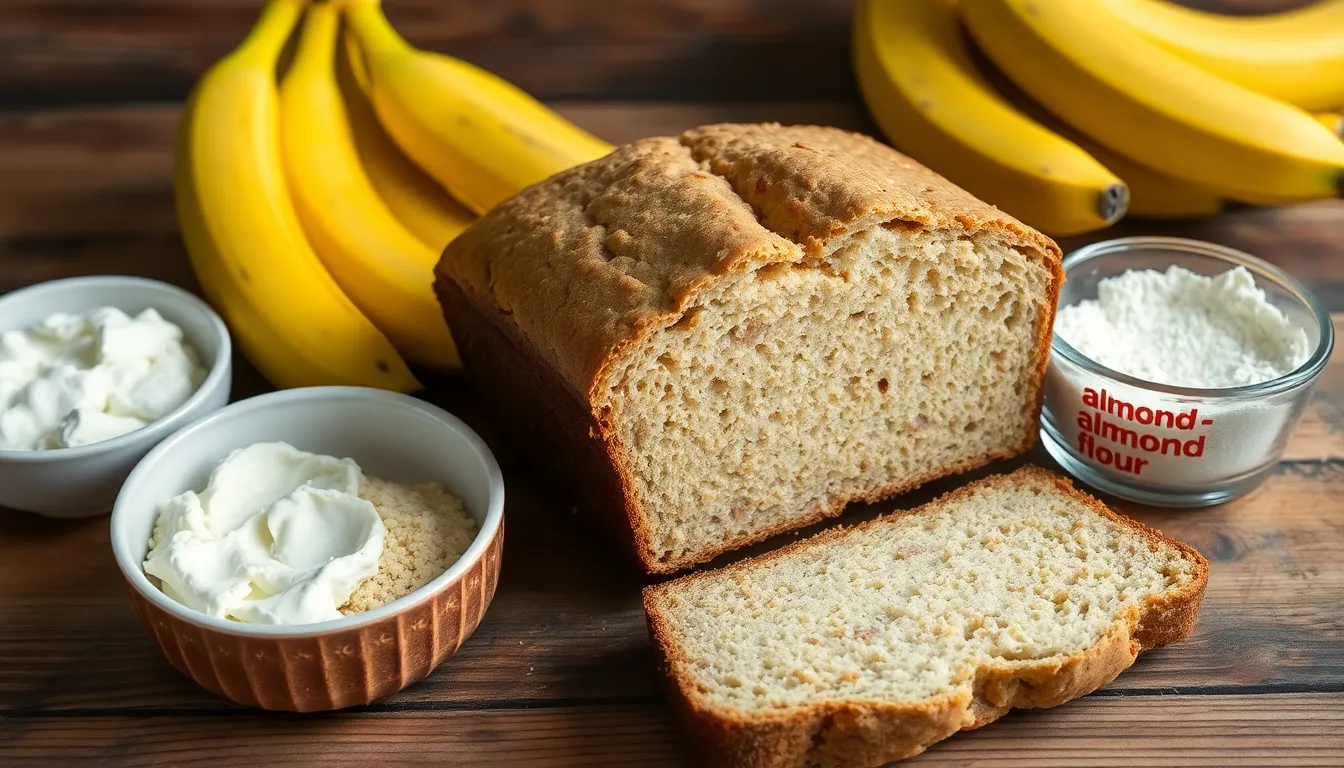
Our cottage cheese banana bread delivers exceptional nutritional value that sets it apart from traditional banana bread recipes. The addition of cottage cheese transforms this beloved treat into a protein powerhouse that supports your health goals while satisfying your sweet cravings.
Protein Content Boost
The most important advantage of our cottage cheese banana bread lies in its impressive protein content. Each slice provides approximately 6 grams of protein, thanks to cottage cheese contributing over 24 grams of protein per cup. This substantial protein increase makes every slice a satisfying snack that keeps you fuller for longer periods compared to regular banana bread.
Enhanced Moisture and Reduced Fat
Cottage cheese serves as a natural moisture enhancer in our recipe, creating an incredibly soft and tender texture without requiring excessive butter or oil. This substitution significantly reduces the overall fat and calorie content while maintaining the rich, moist quality we all love in banana bread. The result is a lighter yet equally delicious treat that doesn’t compromise on taste or texture.
Blood Sugar Balance
The protein content in cottage cheese provides remarkable benefits for blood sugar management. Our cottage cheese banana bread has a lower glycemic index compared to traditional versions, which means it causes a more gradual rise in blood sugar levels. This slower absorption helps maintain steady energy levels and prevents the rapid spikes and crashes associated with high sugar foods.
Nutritious Alternative
Our recipe creates a naturally lower sugar and fat alternative to conventional banana bread recipes. The cottage cheese acts as a functional ingredient that replaces some of the oil or butter typically required, resulting in a more nutritious baked good without sacrificing flavor or satisfaction.
| Nutritional Comparison | Traditional Banana Bread | Cottage Cheese Banana Bread |
|---|---|---|
| Protein per slice | 2-3 grams | 6 grams |
| Fat content | Higher | Reduced |
| Glycemic index | Higher | Lower |
| Sugar content | Higher | Lower |
Gluten-Free Flexibility
When we prepare our cottage cheese banana bread with almond flour instead of traditional wheat flour, it becomes a gluten-free option perfect for those with gluten sensitivities or celiac disease. This adaptation maintains all the nutritional benefits while accommodating various dietary restrictions and preferences.
Variations and Substitutions
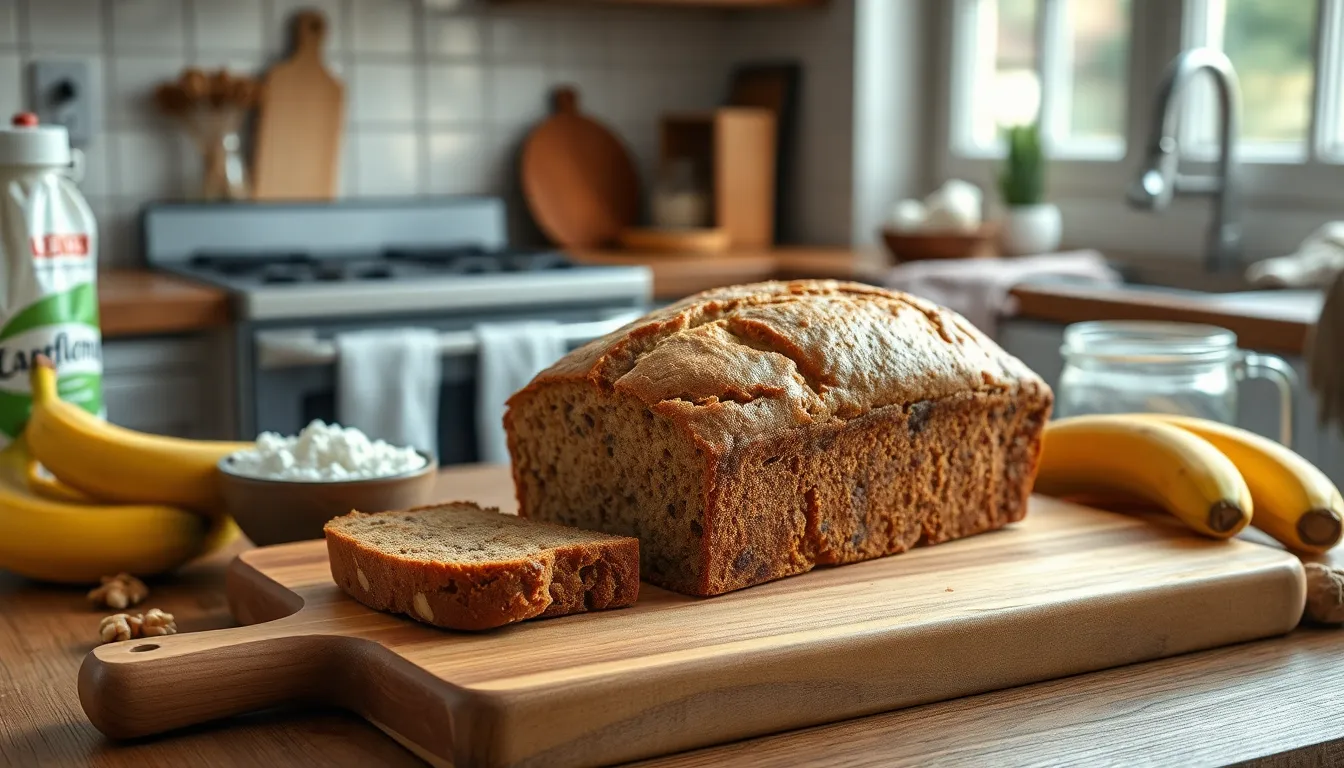
Our cottage cheese banana bread recipe offers incredible flexibility for customization and dietary adaptations. We can easily modify ingredients to suit different preferences and nutritional needs.
Gluten-Free Option
We recommend using almond flour or oat flour as direct substitutes for all-purpose flour to create a gluten-free version. For best results, we suggest using 2½ cups of almond flour or combining 1½ cups oat flour with ½ cup almond flour for optimal texture and flavor balance.
| Flour Type | Amount | Notes |
|---|---|---|
| Almond flour only | 2½ cups | Creates dense, moist texture |
| Oat flour + almond flour blend | 1½ cups + ½ cup | Provides lighter consistency |
Rice flour and gluten-free all-purpose blends don’t work as direct substitutes due to their different absorption rates and textures. We find that almond and oat flour combinations deliver the most consistent results for gluten-free cottage cheese banana bread.
Vegan Alternative
Creating a vegan version requires replacing both eggs and cottage cheese with plant-based alternatives. We substitute each egg with a flax egg made from 1 tablespoon ground flax mixed with 2.5 tablespoons water.
For the cottage cheese replacement, we blend silken tofu until smooth or use thick unsweetened plant-based yogurt to mimic the original texture and moisture. Since dairy-free cottage cheese alternatives are limited, we often increase applesauce or oil content to ensure adequate moisture in the final product.
Flavor Variations
We love improving our cottage cheese banana bread with popular mix-ins like walnuts, chocolate chips, or fresh blueberries for added texture and taste. Sweetener adjustments work well too – we can replace granulated sugar with maple syrup or honey according to personal preference.
Spice variations include extra cinnamon, vanilla extract, or citrus zest for brightness. Nutmeg and cardamom add warm complexity to the flavor profile. For seasonal twists, we substitute part of the mashed banana with sweet potato or pumpkin puree.
Moisture and fat content can be adjusted by swapping applesauce for oil or vice versa, depending on desired richness. These modifications allow us to create countless variations while maintaining the protein-packed benefits of our original cottage cheese banana bread recipe.
Troubleshooting Common Issues
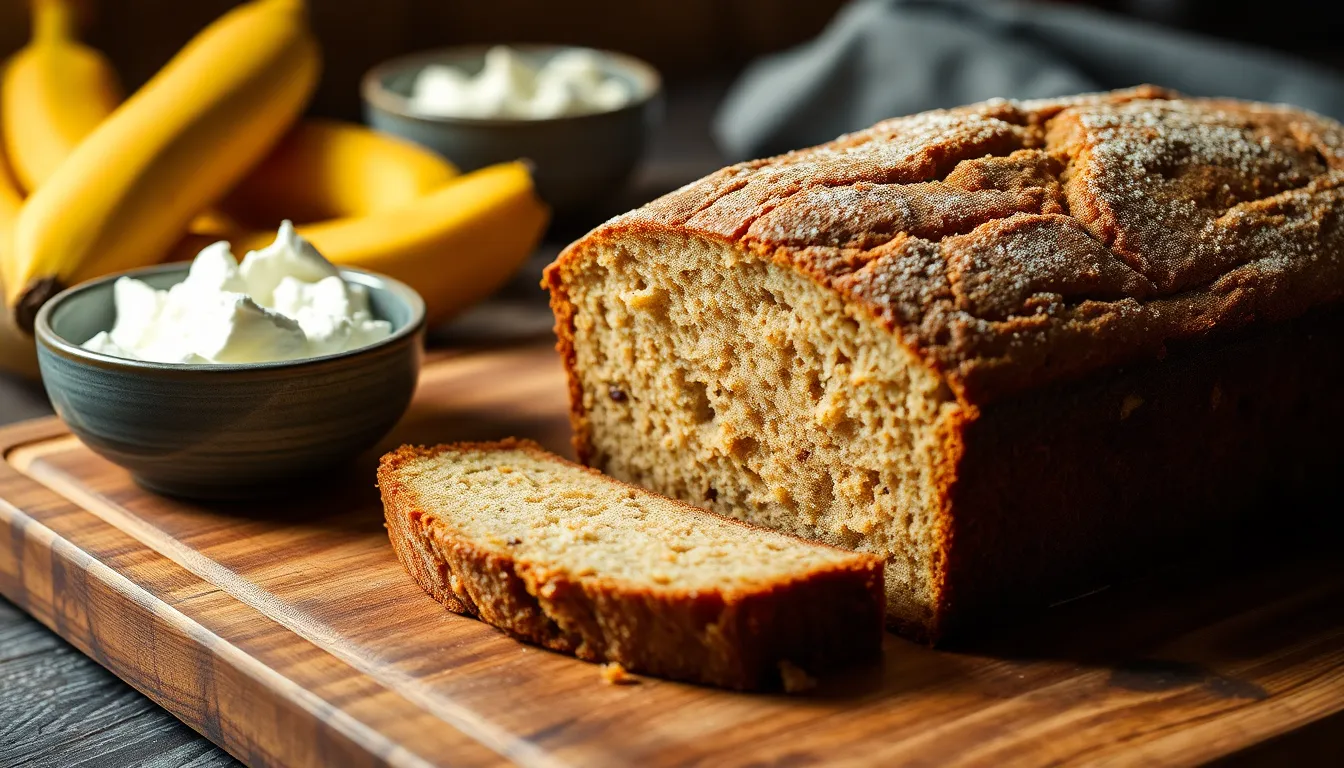
Even with our carefully crafted cottage cheese banana bread recipe, you might encounter a few challenges along the way. We’ve compiled answers for the most common problems to ensure your bread turns out perfectly every time.
Dry or Crumbly Texture
Dryness ranks as the most frequent issue we see with cottage cheese banana bread. Overbaking causes the moisture to evaporate, leaving you with a dense, crumbly loaf. We recommend checking for doneness at the 50-minute mark using a toothpick inserted into the center. The toothpick should come out with just a few moist crumbs attached.
Overmixing the batter also contributes to dryness by developing too much gluten in the flour. Mix your wet and dry ingredients separately, then combine them just until no dry flour remains visible. The batter should look slightly lumpy rather than smooth.
Using cottage cheese with adequate fat content helps maintain moisture throughout the baking process. We suggest choosing cottage cheese with at least 2% to 4% fat content for optimal results.
Uneven Texture from Cottage Cheese Lumps
Large cottage cheese curds can create an uneven texture in your finished bread. Blending the cottage cheese until smooth before adding it to your wet ingredients eliminates this problem entirely. A regular blender or food processor works perfectly for achieving the silky consistency we want.
Alternatively, you can press the cottage cheese through a fine-mesh sieve if you don’t have a blender available. This method requires more effort but produces similar results.
Bread Browning Too Quickly
Rapid browning on the surface while the interior remains undercooked presents another common challenge. Cover your loaf pan with aluminum foil during the last 15 to 20 minutes of baking time. This prevents the top from becoming too dark while allowing the center to finish cooking properly.
Positioning your oven rack in the center rather than the top third also helps prevent excessive browning. The middle position provides more even heat distribution throughout the baking process.
Sunken or Dense Center
A sunken center typically indicates underbaking or incorrect ingredient ratios. Ensure your oven temperature reaches exactly 350°F (175°C) before placing the bread inside. Oven thermometers provide accuracy beyond the built-in temperature gauge.
Check that your baking soda and baking powder remain fresh and active. Both leavening agents lose potency over time, with baking soda lasting about 2 years and baking powder remaining effective for 18 months when stored properly.
Difficulty Removing from Pan
Sticking occurs when we skip proper pan preparation or attempt to remove the bread too early. Line your loaf pan with parchment paper, leaving overhang on the sides for easy removal. Greasing the pan thoroughly with butter or cooking spray provides additional insurance against sticking.
Allow the bread to cool in the pan for exactly 10 minutes before attempting removal. This cooling period lets the structure set while preventing the bread from breaking apart during transfer.
Conclusion
We’ve shown you how cottage cheese banana bread transforms ordinary ingredients into an extraordinary treat that’s both delicious and nutritious. This protein-packed version delivers all the comfort of traditional banana bread while offering superior health benefits that make it perfect for any time of day.
The beauty of this recipe lies in its versatility and forgiving nature. Whether you’re following the classic version or experimenting with our suggested variations we’re confident you’ll achieve bakery-quality results in your own kitchen.
With proper storage techniques and make-ahead options this cottage cheese banana bread becomes a convenient go-to option for busy schedules. We encourage you to try this recipe and discover why so many home bakers are making the switch to this healthier alternative that doesn’t compromise on taste or texture.
Frequently Asked Questions
What makes cottage cheese banana bread different from regular banana bread?
Cottage cheese banana bread contains added cottage cheese, which boosts the protein content to approximately 6 grams per slice. The cottage cheese makes the bread more moist and fluffy while being completely undetectable in flavor. This creates a healthier, protein-packed alternative to traditional banana bread with better texture and nutritional value.
Can I taste the cottage cheese in the banana bread?
No, the cottage cheese is completely undetectable in flavor when properly incorporated into the batter. It only enhances the bread’s texture by making it more moist and fluffy. For the smoothest results, blend the cottage cheese until smooth before adding it to prevent any lumps in the final product.
How ripe should the bananas be for this recipe?
Use overripe bananas with visible brown spots or “freckles” for optimal flavor and moisture. The riper the bananas, the sweeter and more flavorful your bread will be. Very ripe bananas also mash more easily and distribute more evenly throughout the batter, contributing to better texture.
How long does cottage cheese banana bread stay fresh?
At room temperature, store in an airtight container for up to 3 days. Refrigerate for up to 5 days for longer freshness. For extended storage, freeze for up to 2-3 months. Wrap individual slices before freezing for convenient single servings that thaw quickly.
Can I make this recipe gluten-free?
Yes, substitute all-purpose flour with almond flour or oat flour for a gluten-free version. Use specific measurements as recommended in the recipe for optimal texture. The cottage cheese helps maintain moisture and structure even with gluten-free flour alternatives, making this bread suitable for those with gluten sensitivities.
What type of cottage cheese works best for this recipe?
Both full-fat and low-fat cottage cheese work excellently in this recipe. For the smoothest texture, blend the cottage cheese until smooth before adding to the batter. This prevents lumps and ensures even distribution throughout the bread, resulting in a uniform, moist texture.
Can I prepare the batter ahead of time?
Yes, you can mix the batter the night before and refrigerate for up to 24 hours. Alternatively, freeze unbaked batter for up to 3 months with proper labeling. You can also bake the bread completely and store it at room temperature for 3 days or freeze for longer storage.
Why is my cottage cheese banana bread dense or sunken?
Dense or sunken bread typically results from incorrect ingredient ratios, overmixing the batter, or using expired leavening agents. Ensure your baking soda and baking powder are fresh, mix ingredients just until combined, and measure ingredients accurately. Also, avoid opening the oven door frequently during baking.
How do I know when the bread is done baking?
Insert a toothpick into the center of the loaf. It should come out clean or with just a few moist crumbs. The bread typically bakes for 50-65 minutes at 350°F. If the top browns too quickly, cover with foil and continue baking until the toothpick test indicates doneness.
Can I add mix-ins to this recipe?
Absolutely! Popular add-ins include chopped nuts, mini chocolate chips, oats, seeds, dried fruits, or orange zest. Add up to 1/2 cup of mix-ins to enhance flavor and nutrition without compromising the bread’s texture. Fold them in gently after combining wet and dry ingredients.

